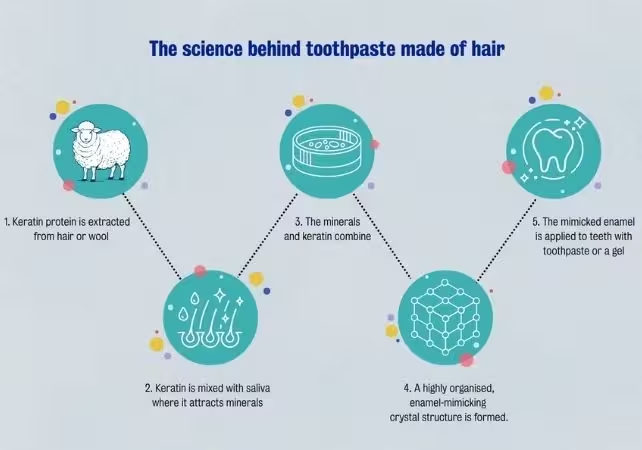5 Minutes
From Wool to White — a New Route to Enamel Regeneration
Researchers at King's College London have developed a method that uses keratin — a common structural protein found in hair and wool — to stimulate the formation of enamel-like mineral on teeth. The approach could lead to topical products such as daily toothpastes or clinician-applied gels that rebuild worn or decayed enamel, offering a potential alternative to synthetic resins and non-repairing fluoride treatments.
Scientific background: Why teeth don’t heal like bones
Tooth enamel is a highly mineralized tissue composed mostly of hydroxyapatite crystals. Unlike bone, enamel has no living cells to repair damage once it is lost. Erosion from acidic diets, insufficient oral hygiene, or age-related wear exposes the softer dentin beneath and initiates permanent structural loss. Dental caries and enamel erosion can reduce a tooth's strength and stiffness by up to 95 percent, leading to pain, sensitivity, cavities, and in severe cases tooth loss and jawbone changes.
How keratin drives enamel-like mineral formation
In laboratory experiments the team extracted keratin from sheep wool and suspended it in an artificial saliva solution rich in calcium and phosphate ions. The keratin acted as a nucleation scaffold, drawing mineral ions out of the fluid and guiding their assembly into a dense, enamel-like layer. When combined with different keratin types and additional proteins, the researchers engineered a hierarchical, nested structure that mimicked enamel's multi-level architecture — improving mechanical strength, durability and resistance to degradation.
Key discoveries and implications
The keratin-derived coating filled small lesions and formed a pearlescent, enamel-like surface that restored protective and functional properties to treated areas. Because the material is protein-guided mineral rather than a purely synthetic resin, it more closely resembles native enamel in structure and could avoid some toxicity and sustainability issues associated with current restorative materials. The researchers propose that keratin-based formulations might be delivered as over-the-counter toothpastes or as professional varnishes applied in clinics.

Advantages over current treatments
Current restorative approaches—composite resins and fillings—are mechanically inferior to natural enamel, can require replacement over time, and rely on petroleum-derived polymers and nonrenewable resources. Fluoride helps slow demineralization but cannot fully restore lost enamel. A keratin-guided mineralization approach leverages a biological scaffold to regenerate mineral in situ, potentially enabling durable repair and reducing resource waste.
Practical outlook: timeline, scalability, and sustainability
The investigators suggest that keratin-based enamel boosters could reach the market within two to three years, depending on clinical testing and industry partnerships. The production model also supports circular-economy goals: keratin can be sourced from agricultural or textile byproducts — a waste-to-health concept that could reduce environmental footprint while delivering a medical benefit. Nonetheless, further testing is required to demonstrate long-term adhesion, resistance to oral forces, and safety in diverse patient populations.
Limitations and next steps
Lab-based mineralization differs from conditions in the human mouth. Key challenges include ensuring bioavailability of minerals deep within lesions, confirming durability under chewing forces and fluctuating pH, and meeting regulatory standards for dental products. Large-scale clinical trials will be essential to determine whether keratin formulations can repair deep cavities or are most effective for early-stage erosion and surface remineralization.
Expert Insight
Dr. Maria R. Santos, a fictional dental materials scientist with experience in biomimetic mineralization, comments: 'Using keratin as a template for hydroxyapatite assembly is an elegant example of biomaterials design. If clinical results validate lab findings, this method could shift preventive dentistry from protective maintenance to active regeneration. The scalability and sourcing of keratin from textile waste make the idea commercially and environmentally attractive, but long-term wear studies will be decisive.'
From the study team, Sherif Elsharkawy, an odontologist at King's College London and the study's senior author, observed: 'We are entering an exciting era where biotechnology allows us to not just treat symptoms but restore biological function using the body's own materials. With further development and the right industry partnerships, we may soon be growing stronger, healthier smiles from something as simple as a haircut.'
Related technologies and future prospects
The keratin-enamel approach complements other biomimetic strategies, including peptide-guided mineralization and calcium phosphate nanomaterials. Combined strategies could improve penetration into subsurface lesions or integrate antimicrobial agents to address caries-causing bacteria. Longer-term, regenerative approaches may reduce the need for repeat restorations and shift dental care toward prevention and biological repair.
Conclusion
Keratin-based enamel regeneration represents a promising biomaterial advance with potential to repair early enamel loss, restore function and lighten the environmental footprint of dental materials. While laboratory results are encouraging and a near-term timeline is plausible, clinical validation, durability testing, and regulatory review remain necessary steps before keratin toothpastes or varnishes become widely available. If successful, the technology could transform routine oral care and illustrate how waste-derived biomolecules can be repurposed into high-value medical solutions.
Source: sciencealert


Leave a Comment